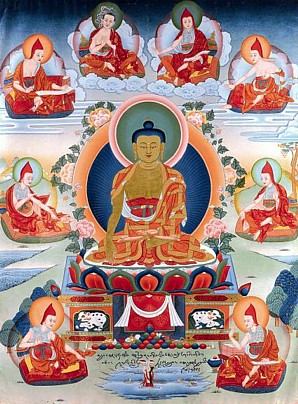Tengyur: Difference between revisions
Jump to navigation
Jump to search
No edit summary |
No edit summary |
||
| Line 1: | Line 1: | ||
'''Tengyur''' ([[Wyl.]] ''bstan 'gyur'') – the commentaries on the teachings of the [[Buddha]]. The Tibetan Buddhist canon is divided into the actual words of the Buddha contained in the [[Kangyur]], and the treatises composed by the learned and accomplished masters of India, which are contained in the Tengyur. | [[Image:Buddha and 6 Ornaments 2 Supreme.jpg|frame|[[Buddha]] with the [[Six Ornaments and Two Supreme Ones]]]]'''Tengyur''' ([[Wyl.]] ''bstan 'gyur'') – the commentaries on the teachings of the [[Buddha]]. The Tibetan Buddhist canon is divided into the actual words of the Buddha contained in the [[Kangyur]], and the treatises composed by the learned and accomplished masters of India, which are contained in the Tengyur. | ||
[[Ringu Tulku Rinpoche]] has said: | [[Ringu Tulku Rinpoche]] has said: | ||
Revision as of 15:43, 21 July 2009

Tengyur (Wyl. bstan 'gyur) – the commentaries on the teachings of the Buddha. The Tibetan Buddhist canon is divided into the actual words of the Buddha contained in the Kangyur, and the treatises composed by the learned and accomplished masters of India, which are contained in the Tengyur.
Ringu Tulku Rinpoche has said:
- "All the teachings in Buddhism are divided into two types: the direct teaching of the Buddha and the commentaries. The teachings that come directly from the Buddha are called sutras in Sanskrit and Kangyur in Tibetan. You might call them the scriptural or canonical teachings. The commentaries are called shastras in Sanskrit and tenchö in Tibetan. In Tibetan, this Kangyur is 108 volumes, and the Tengyur, the translation of the commentaries that come from India, is 228 volumes. The commentaries written later on by Tibetans and others can also be called tenchö."